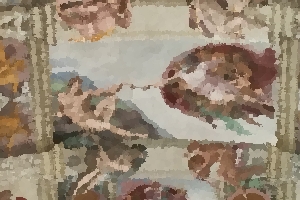The walls
The chapel walls were painted in just eleven months, from July 1481 to May 1482, by some of the most famous Italian Renaissance painters of the era. The paintings are depictions of scenes from the Old and the New Testament and a gallery of portraits of historical Popes. The north wall of the chapel contains eight panels that depict the life of Christ, from his baptism to the last supper. The south wall shows stories of Moses. The north and south walls each contain frescoes painted by Perugino, Botticelli, Ghirlandaio, and Rosselli. The chapel's entrance wall once had the final episodes of Christ and Moses's lives as depicted by Ghirlandaio and Signorelli, respectively. However, these were destroyed in 1522 due to the chapel's structural collapse, and the scenes were repainted by Hendrik van den Broeck and Matteo da Lecce. Behind the altar of the chapel is The Last Judgment, painted by Michelangelo between 1536 and 1541. This is the largest single fresco painted in the sixteenth century and is simply astonishing in its detail and vivid coloring.
The Ceiling
 A view of the Sistine Chapel's famous ceiling painting, The Creation of Men, by Michelangelo. [Report image]
A view of the Sistine Chapel's famous ceiling painting, The Creation of Men, by Michelangelo. [Report image]Considered by many to be the most outstanding achievement of Renaissance artist Michelangelo, the Sistine Chapel ceiling is an awe-inspiring work of art. It is a huge work in terms of both subject matter and size, with incredible attention to detail, from facial expressions to hand gestures, even on the figures surrounding the nine main panels. Just as impressive is the tremendous amount of work that went into creating it—Michelangelo painted the piece over a period of four years, enduring considerable physical discomfort from standing upright close to the ceiling, with his face turned towards it, for hours at a time.
The Sistine Chapel's original ceiling was of a blue sky dotted with golden stars; it was not until 1508 that Pope Julius II commissioned Michelangelo to repaint the area. The ceiling of the chapel, as painted by Michelangelo, depicts nine scenes from the Book of Genesis, perhaps the most famous of which is The Creation of Adam. The ceiling is more than twenty meters above the Chapel floor; however, the painted figures are so large and well-defined that a viewer on the floor can easily see the smaller details of these stunning frescoes.